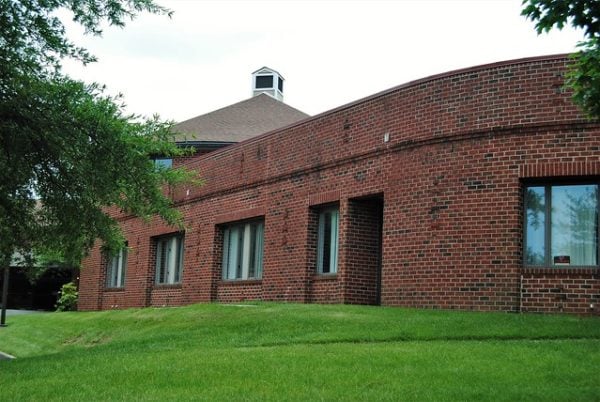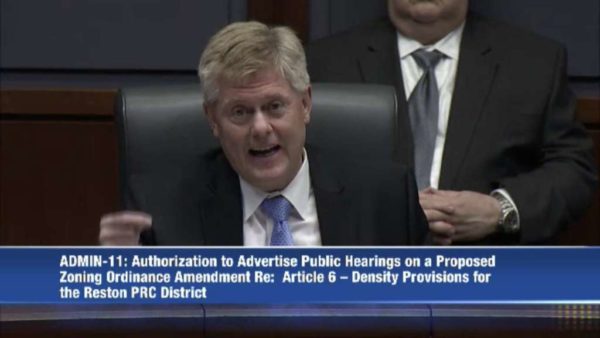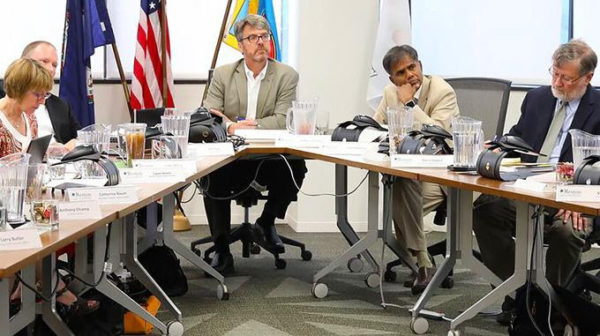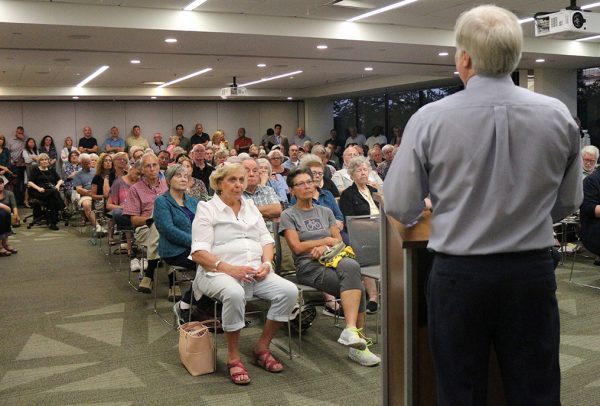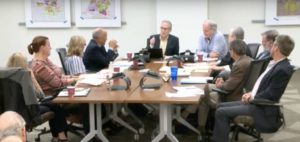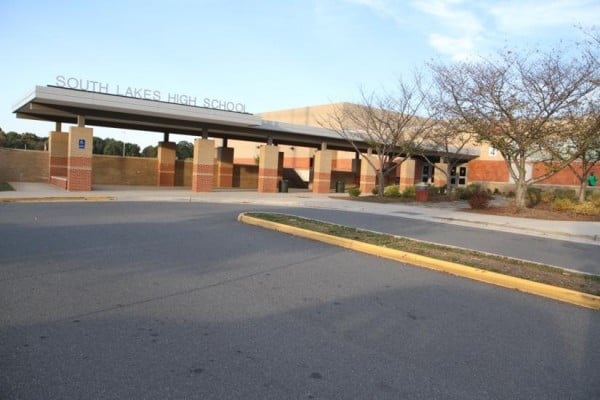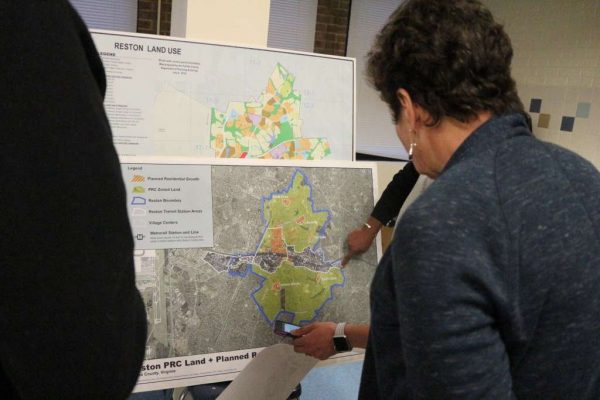The Fairfax County Board of Supervisors unanimously approved Campus Commons on Tuesday — the first major redevelopment project in a transit-oriented area in Reston near established neighborhoods. Although community criticism pushed developer TF Cornerstone to amend its plan, citizens and resident groups remained concerned about the scale and impact of the 12-acre development.
TF Cornerstone plans to redevelop 1900-1902 Campus Commons Drive with two residential towers with 656 units, an office building, and seven public parks. Two office buildings will remain on the site.
The scale of the project — as well as a controversial proposed on-grade pedestrian crossing at Wiehle Avenue and the Dulles Toll Road — prompted the eruption of community consternation and the formation of Rescue Sunrise Valley, a community group that pushed the developer to scale back the site.
Last month, TF Cornerstone shifted roughly 86,550 square feet from an office building near Sunrise Valley Drive to a residential building and reduced its height from 12 to seven stories. The setback along the curb of Sunrise Valley Drive was also increased to a minimum of 50 feet.
The approval of the project highlights the challenge of transitioning the community to mass transit. Community planners rely on the hope that transit-oriented developments like Campus Commons will reduce the number of vehicles — a transition that will likely happen over time and raises questions about community impacts in the interim.
At Tuesday’s Board of Supervisors’ meeting, residents said the project adds additional congestion in an area that already has high traffic volumes.
Although the developer’s plans show an on-grade crossing at the intersection of Wiehle Avenue and the toll road, TF Cornerstone will work with the county to explore three options for a pedestrian bridge. The study group, which will also represent local residents, will work for up to three years to explore the best way forward. TF Cornerstone committed to constructing the bridge of contributing $1.5 million to help finance any alternative.
Michelle Kimmel, a member of the Coalition for a Planned Reston, said that while she supports transit-oriented communities, Campus Commons does not hit benchmarks for well-planned development, especially because it is not harmonious with existing residential areas.
“We got people ending up on a pork chop in the middle of the toll road,” Kimmel said. “It’s just beyond me how this project can succeed.”
Reston Association President Cathy Baum said the project illustrates the association’s longstanding concern about high densities planned for transit station areas and the inadequacy of transportation to keep up with development.
Baum also encouraged the board to remove the on-grade crossing at Wiehle Avenue from plans “as an assurance to our members that it is truly not an option.”
Hunter Mill District Supervisor Cathy Hudgins thanked residents for their involvement in the project and said she hopes the county will work diligently to ensure the developments like Campus Commons reduce traffic in the long-term. Hudgins also noted that the county’s planning documents call for redevelopment projects like Campus Commons in the corridor of Sunrise Valley Drive and Sunset. Hills Road.
Hudgins also said she hopes the developer will continue to work with residents as the project is built.
Photos via handout/Fairfax County Government
Candidates for Hunter Mill District Supervisor Discuss Reston’s Future — Candidates running for the seat submitted answers to the Coalition for a Planned Reston’s questionnaire on the community’s future. Topics include whether or not the Fairfax County Planning Commission should increase the density of Reston’s Planned Residential Community and the elimination of waivers granting exceptions to open space requirements. [Coalition for a Planned Reston]
“Nutrition for a Wealth of Health” Event Tonight — An in-store nutritionist from Giant Foods discusses eight steps to a wealth of health at Reston Regional Library from 7-8 p.m. [Reston Regional Library]
Virginia’s “LOVE” Letters Say Goodbye to Reston Town Center — The iconic letters move from RTC, their home for two days, to the Fairfax County Government Center. Next, they’ll head to Wolf Trap from July 12-24 and Frying Pan Farm Park from July 26 through August 4. [Reston Patch]
Photo via vantagehill/Flickr
 This letter was submitted by Bruce Ramo, a member of community groups Reclaim Reston and Coalition for a Planned Reston. It does not reflect the opinions of Reston Now. We publish article and opinion contributions of specific interest to the Reston community. Contributions may be edited for length or content.
This letter was submitted by Bruce Ramo, a member of community groups Reclaim Reston and Coalition for a Planned Reston. It does not reflect the opinions of Reston Now. We publish article and opinion contributions of specific interest to the Reston community. Contributions may be edited for length or content.
It’s a lot to ask of everyone in Reston to understand the minutiae of land use law. We have families and jobs and other responsibilities. And, after all, we chose to live in a planned community with loads of covenants and design guidelines. We can leave it to the “experts.” Except we can’t.
Like it or not Restonians have little say over how our community is being developed, and the elected official who should be watching out for us, our county supervisor, has retreated to a defensive posture. She frequently tells us “we just don’t understand” and has suggested that Reston, perhaps the most progressive community in Virginia, opposes the proposed increase in the density cap out of fear of “the other” sharing our neighborhoods. This is simply untrue. The community group Coalition for a Planned Reston proposed an increase in the required affordable housing levels for Reston–our supervisor did not support us.
So what’s the big deal about increasing the density cap, from 13 to 15 persons per acre, in the primarily residential areas of Reston called the Planned Residential Community district? The supervisor and county staff tells us that the increase is necessary to implement 2015 changes to the Reston Master Plan. Those changes allow significantly increased density in the Village Centers and other “hot spots” throughout established neighborhoods of Reston, far from the Metro stations. We are also scolded about speaking up now because, as the story goes, the public had lots of opportunities back in 2014-15 to comment on changes to these portions of the Reston Master Plan changes called “Phase 2.” (Phase 1 involved only the transit station areas.)
Our supervisor and county staff frequently repeat the myth of significant community involvement in Reston Master Plan Phase 2. However, the county disbanded the citizen “task force” set up for community review before the Phase 2 review. There simply was little in-depth public review of the changes that are the driver for increasing the density cap.
Why should you care? Because if the zoning density cap is lifted, the ability of the community to push back on significant high-density development in our established residential neighborhoods effectively will be eliminated. Sure, each of us can watch out for individual development applications, but the force of overall community oversight based on a reasonable density cap will have been taken from us forever.
We have invested our financial resources, identities and emotional loyalty to Reston as a planned community. The density increase is an existential threat to those investments.
Take action to protect your hometown. Help maintain the current density cap and the modicum of control it provides over those who would rob us of a community grounded in diversity, environmental stewardship and quality of life.
Attend the Jan. 23 meeting of the Planning Commission at the Fairfax County Government Center at 7 p.m. (and wear your yellow shirts!)
Write to our County officials: Supervisor Hudgins: [email protected]; other Fairfax County Supervisors: [email protected]; and the Fairfax County Planning Commission: [email protected].
File photo
 This letter was submitted by Dennis K. Hays, the president of the Reston Citizens Association. It does not reflect the opinions of Reston Now. We publish article and opinion contributions of specific interest to the Reston community. Contributions may be edited for length or content.
This letter was submitted by Dennis K. Hays, the president of the Reston Citizens Association. It does not reflect the opinions of Reston Now. We publish article and opinion contributions of specific interest to the Reston community. Contributions may be edited for length or content.
Fairfax County has proposed to increase the population cap of the Reston Planned Residential Community district (PRC) from the long-standing 13 persons per acre (ppa) to as many as 15 persons per acre — which when combined with already approved projects would add an additional 30,000 people above our current population for the established, primarily residential areas of Reston. Please keep in mind this doesn’t include the areas around the Metro, where the county is on track to authorize building enough high rises to add an additional 80,000 residents.
Here are 10 reasons why the cap should be left alone. There undoubtedly are more.
1. If the ceiling (13) is shattered, there is no new ceiling: Fourteen or 15 today will be 16 tomorrow, 17 the day after and 20 down the road. The current 13 ppa has been in effect since Robert Simon created Reston. Does anyone believe the county will stop at 15?
2. The county bases its proposal on numbers that are rough estimates at best, gross misrepresentations at worst. The county has provided no established methodology that can be used to arrive at accurate numbers. The county promised to meet with the Coalition for a Planned Reston (CPR) and the Reston Association to agree on a methodology before any action would be taken. We’re still waiting.
3. There are thousands of dwelling units (what the county calls where we live) that have been approved but not yet built (1,400 at Spectrum alone). How will all these already authorized residences affect roads, schools, first responder services, and parks? The county counts them for cap purposes, but not for the provision of services.
4. The county doesn’t count people who live in affordable or workforce housing as part of the cap, despite CPR’s frequent complaints. These neighbors of ours have kids in school, drive to work, go to the library and play ball in the parks just like everyone else. So why are they second-class citizens in the county’s eyes?
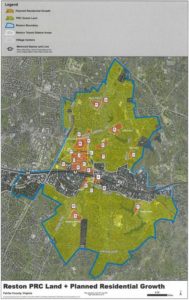 5. Although the county is in a frenzied hurry to authorize new high-density construction, they are in no hurry to provide the needed infrastructure that should go along with it. Reston has received no funding from the county in its current transportation budget. There is no land for additional athletic fields or open space confirmed. The Master Plan calls for infrastructure to be phased in with development. County officials talk for hours about their “plans” for roads, schools, parks, etc. but when pressed they are forced to admit they have no funds, no identified land and no timetable for the required infrastructure.
5. Although the county is in a frenzied hurry to authorize new high-density construction, they are in no hurry to provide the needed infrastructure that should go along with it. Reston has received no funding from the county in its current transportation budget. There is no land for additional athletic fields or open space confirmed. The Master Plan calls for infrastructure to be phased in with development. County officials talk for hours about their “plans” for roads, schools, parks, etc. but when pressed they are forced to admit they have no funds, no identified land and no timetable for the required infrastructure.
6. Why the push to raise the cap now? Even using the county’s questionable numbers there aren’t any development proposals that take us over the 13 ppa limit. So what is the rush? Why not use this time to assess how we grow in phase with the services needed to support our neighborhoods?
7. Until five years ago the county had an official on the Planning staff dedicated to working on Reston proposals. This provided some coordination. They haven’t replaced that official. Now the county can’t say specifically where the development allowed by their increased cap will go, although it doesn’t take much to figure this out — initially it will go to build high rises in the Village Centers, take parking spaces away from the library and push again on St. Johns Wood and the other “hot spots” the county believes should be more urban. And by urban they mean you will only walk, bike or Metro to work, the grocery store, the movies, to see family and friends and everywhere else. And then they will come for the golf courses.
8. The Reston Master Plan was changed in significant ways after community representatives had signed off on what they believed to be the final version. Leaving that aside for the moment, the Virginia Code calls for Master Plans to be reviewed and updated at least every five years. The Master Plan for the Metro areas is up for review next month. The PRC portion must be updated no later than next year. Yet the county has taken no steps to begin the review process. Given all that has happened, isn’t it time to pause and take stock?
9. The more you dig into the county’s assertions, the shakier they become. The CPR and the Reston Association met with county officials in four sub-groups last summer. It became immediately apparent that a lot more information and data was needed to properly review and assess the issues surrounding the cap. We had agreement coming out of all four meetings that the additional information would be developed before any action on the cap was taken. CPR and RA asked over 30 specific questions. On Dec. 11 the county responded by sending a blizzard of paperwork — that restated what we had already been told but provided no new information. Why hasn’t the county met its commitment to answer these questions? Could it be that the answers would be more damning than not answering?
10. The county speaks often of the need for “community involvement” and the Master Plan lists community participation as the foundation stone on which all else rests. So why has the county refused to meaningfully engage with its citizens? We remain ready to work with the county to further the unique vision of Reston as a balanced, welcoming community that takes to heart our motto of “live, work, play.” Is that too much to ask?
If you agree that raising the cap is unneeded and counterproductive, please let our Fairfax County Supervisor ([email protected]), the other supervisors ([email protected]), the Planning Commission ([email protected]) and the Department of Planning and Zoning ([email protected]) know. We can make this a Happy New Year if we act together.
— Dennis K. Hays
Fairfax County’s Board of Supervisors disagreed about community input on contentious proposed zoning changes, before authorizing public hearings early next year on the changes at their meeting today.
The proposal, which would increase the population density in Reston, has sparked a backlash from community groups, including the Reston Association, Coalition for a Planned Reston and Reston 2020.
County planning officials have argued that the change is needed to put into action Reston’s Master Plan, which allows for future growth over the next 40 years.
Dranesville District Supervisor John Foust vented frustration at the Dec. 4 meeting that Reston residents have not heard back from the county regarding the public hearings for the zoning proposal.
In response to Foust’s concerns, Hunter Mill District Supervisor Cathy Hudgins said that locals have had plenty of opportunities to get the desired information.
County officials began small workgroup sessions hosted by the Coalition for a Planned Reston, a grassroots organization, and the Reston Association in July to discuss the controversial plan.
“Yes, there are some questions that people have,” Hudgins said. “Those questions have been answered before or are not relevant to this.”
Hudgins stressed that consideration of the proposed zoning changes is moving forward because of the work, including 13 follow up meetings since May and regular meetings with the Reston Association, already done.
Hudgins praised the “noble” staff for answering community questions.
Braddock District Supervisor John Cook said that verbal responses from staff to locals are not enough, adding that the community would benefit from written questions and answers available online.
“I don’t think it’s enough to have oral questions,” Cook said. “Not everyone can get to public meetings.”
Cook added that community input must have limits. “It’s fair to have a cut off date for questions,” he said.
The Fairfax County Planning Commission has 100 days from the referral — the staff report published Dec. 4 — to take action on the zoning proposal. The Board of Supervisors authorized public hearings on the zoning changes for 7:30 p.m. on Jan. 23 and at 4:30 p.m. on March 5.
“The clock starts today,” Lee District Supervisor Jeff McKay said.
.@johnfoustva venting frustration that Reston residents not hearing back from @fairfaxcounty when it comes to advertising public hearings for zoning ordinances. To which the Dept. of Planning/Zoning places blame on Reston—never guaranteed response to every inquiry. Wow, not good! pic.twitter.com/bAcnJ3jtPh
— Fairfax County Memes (@FairfaxMemes) December 4, 2018
Following a series of meetings with county officials about a planned population density increase in Reston, Reston Association’s Board of Directors is urging the county to build more assertive, clearer statements into its planning and development mechanisms.
At a special work session Monday night, board members considered adding language to specify a population cap. After some discussion, the board concluded it was best to avoid locking in a specific number until other items were addressed. Acting CEO Larry Butler said it was better for RA to not take a position on the issue yet.
“This takes more of a position which I’m sure a lot of people in the community would like to see but I’m just saying that it has not been the tack of the board,” Butler said.
RA board president Andy Sigle said adding a specific population cap could be addressed in a subsequent letter. The letter itself raises the following points:
- Provide a clear statement that Reston’s Village Centers, with the exception of Lake Anne and Tall Oaks, are planned to reflect land uses that currently exist
- Like the Tysons plan, Reston’s plan should include periodic updates on how development and public infrastructure are being developed, binding commitments for additional infrastructure and a formal transportation operations analysis
- A review of the assumptions and methodology that drives the Reston Transportation Network Analysis
- Implementation of a collaborative mechanism between RA, the county, the Northern Virginia Regional Park Authority, the Fairfax County Park Authority and Reston Town Center Association to create a plan to increase the capacity of Reston’s recreational facilities to serve new residents
- The addition of clearer, more assertive statements that ensure development and infrastructure capacity are developed simultaneously and as demands arise
- Establish a realistic plan to add increased school capacity to serve new student populations
- Remove the grid of streets road connection between American Dream Way and Isaac Newton Square
- Clarify that a land use category that applies to the Harrison Apartments and the Charter Oaks Apartments applies only to those two parcels
As one of the original members of the Coalition for a Planned Reston, the grassroots organization heavily involved in discussions with the county, board member John Mooney said RA must recognize that it has no legal power in these discussions. Mooney said the organization should exercise its political power to push for changes as necessary.
“There is a power to truth and we have insisted that we want reason to show what the truth is… we have made it not an act of the will but an act of reason,” Mooney said.
More information on the proposed zoning ordinance amendment is available online. The county has not yet released a schedule detailing when the amendment will be formally introduced at the county level.
File photo via Reston Association
After a round of meetings with county officials about a plan to increase Reston’s population density, the Coalition for a Planned Reston is asking Fairfax County officials to hold off on officially proposing the amendment until specific issues raised in the meetings are addressed.
A series of workgroup sessions concluded on July 30 regarding the proposal, which would increase the overall per person density in Reston’s Planned Residential Community from 13 to 16 people per acre.
CPR is requesting the following actions, agreed upon by stakeholders involved in the discussions, go into effect:
“Clarification and correction of the Reston Master Plan (RMP), identification of additional information that the County intends to share with the public, and acknowledgment of areas that require further dialogue.”
No dates for the formal introduction of the proposal have been set yet. CPR plans to hold a community meeting after Labor Day to discuss the outcome of the county meetings and seek additional community feedback.
File photo
At the last workgroup meeting on a controversial zoning amendment, county officials stressed that population density increases proposed in Reston’s comprehensive plan are broad targets that will be gradually implemented over the next 30 years.
The meeting, held Tuesday night, was the last in a series of discussions on the county’s proposal to increase Reston’s population density from 13 to 16 people per acre in the community’s Planned Residential Community district.
Representatives from the Coalition for a Planned Reston and Reston Association said that while they were not opposed to development, the cumulative impact of increased development without the infrastructure to manage it was a major concern.
Tammi Petrine, co-chair of Reston 2020, said increasing the density cap only invites more developers to push harder for development — a trend that she said is already clearly evident in the streak of major mixed-use projects approved by the Fairfax County Board of Supervisors.
Fred Selden, director of the Fairfax County’s Department of Planning and Zoning, said the community has multiple opportunities between when a development plan is proposed and passed to voice their concerns, suggest alternatives and raise critical issues.
“The community, quite frankly, has to give its judgment,” Selden said.
But others felt that concerns raised by community members have little sway in the overall planning process.
Selden said his office would be open to discussing possible changes to Reston’s comprehensive plan if pressing needs arose. In Tysons, the plan was updated seven years after its passage when the planned grid of streets did not align with what was actually being built.
But Selden also noted that major changes to planned land use intensities are rarely incorporated within five years of a plan’s passage. Late last year, CPR and RA suggested altering Reston’s master plan to make specific changes. He repeatedly stressed that Reston’s plan envisions possible future growth, which may or may not be realized given economic and market constraints.
Redevelopment of Reston’s village centers was also a hot topic during Tuesday’s discussion. Selden stressed that the plan already leaves the door open for high-density redevelopment potential — an element of the plan that was supported by some residents during earlier planning discussions.
“We could have said that there’s no redevelopment potential in the village centers,” Selden said. “But that’s not what we heard from the community.”
Others like John Mooney, a member on RA’s Board of Directors, said planning processes focus on the impacts of development in Transit Station Areas without considering the impact on development in all of Reston.
He said traffic studies have not considered the impact of traffic in Transit Station Areas on the rest of Reston.
“I see no evidence, although I’m awaiting further information,” Mooney said.
Photo via YouTube
(This story was updated on Wednesday at 6:27 a.m. to clarify a quote by John Mooney.)
(Editor’s Note: This story was updated at 4:45 p.m. to remove unclear information about the number of total available seats in the South Lakes Pyramid.)
Local citizen representatives pressed county and school officials on how the school system will mitigate the impact of planned and future development on Reston’s public schools Tuesday night.
The meeting, the third in a series on the county’s proposal to increase the community’s population density, highlighted a major obstacle in managing increased school enrollment: limited and uncertain funding to meet future needs.
Kevin Sneed, who oversees design and construction services for the school system, said new development is not expected to generate many students because of the style of new multi-family units.
Two residential buildings recently built in Tysons generated only 21 students, Sneed said. Student enrollment from new residential development in Reston is expected to increase in the next 20-25 years, he said. Meanwhile, the school system must balance the need for renovations at several schools.
The site for a new high school in the area — especially along the Dulles Suburban Corridor where McNair, Coates and Hutchison Elementary Schools are served — is critical. However, the school system is constrained by lack of funding to purchase a new property. And current plans to mitigate the future impact of development on schools likely will not kick in until development actually takes place, Sneed said. Development may go live years after it is approved by the county, he said.
Stu Gibson, a former school board member of 16 years, said building capacity only once the students impact the system is a “disturbing” strategy. Gibson said he was concerned that the county is planning for additional residences before the infrastructure is in place to handle additional growth — a mode of operation that he said goes against Reston’s comprehensive plan.
Instead of purchasing land, the county and the school system are relying on proffers from developers and negotiating with applicants to see if land for a new high school can be provided, according to Leslie Johnson, the county’s zoning administrator. So far, those negotiations have been unsuccessful. But talks are underway on the county-level to change the formula used to determine how much developers pay based on the expected impact of the development on area schools.
Others worried that viable land for a new school may be limited, especially when parking lots and aging office parks that could be the site for a future school are redeveloped into mixed-use projects.
Johnson said the county is closely evaluating the impact of each development proposal on fire services, schools, parks and other public infrastructure.
“We are keeping track of the cumulative impact, but, at some point, there will be a trigger for some type of development,” Johnson said.
When and how that trigger comes forward remains unclear.
File photo
Piqued by a plan to increase Reston’s population density in select areas, residents pressed county officials to identify specific athletic field options and open space commitments at a work session this week.
During the meeting, the 10-member panel, which included representatives from Reston Association, the Coalition for a Planned Reston and three county officials, discussed how the county plans to ensure future development in and around Reston’s future urban core will incorporate athletic fields and open, community spaces.
While citizen members lauded the county’s efforts to work with developers, some noted that county plans lacked specific assurances on how and when broad commitments would come to reality.
The meeting is the second in a series of work sessions on topics of concern raised by local residents and community organizations as the county mulls a plan to increase Reston’s population density in its Planned Residential Community district planned from 13 to 16 people per acre.
County officials said planning processes are in place to ensure athletic fields and open space requirements are met. Generally, once major developments are built and occupied overtime and needs are generated through pressure created by development, specific requirements for athletic fields will kick in.
However, they remained mum about the location of future athletic fields, noting that negotiations with developers are ongoing and that, once property owners learn a land is being considered for an athletic field, the property’s price is often hiked considerably.
Asked by a member to point to possible locations for fields, Fred Selden, the director of the county’s planning and zoning department, said, “Right now, we can’t.”
In Reston, one athletic field is required for each Transit Station Area and nine are required outside the TSA areas. Upgrades to existing fields may also be considered. Thus far, the developers have committed $10.3 million to go toward athletic fields in the greater Reston area.
So far, funds have remained untouched.
Others called on county officials to aggressively push developers of major mixed-use proposals — like the 36-acre Reston Crescent project — to identify specific plans for athletic fields.
“Those are the examples where the community feels we were being passed by in some way, shape or form,” said Larry Butler, RA’s Acting CEO.
Dennis Hays, president of the Reston Citizens Association, said he was concerned no immediate plans were on the table.
“Everything that we keep talking about is down the road,” Hays, who led the meeting, said.
Andrea Dorlester, manager of the county’s park planning branch, said the county has been aggressive in pushing developers to identify plans for nearly two years. When working with Brookfield, the developer of the Reston Crescent, county staff said they rejected a proposal by the developer to include a small athletic field suitable for children up to the age of eight.
Now, the plan, which is barreling towards final approval later this month, includes a proposal for the developer to purchase seven acres outside the property and convey it to the Fairfax County Park Authority.
Part of the challenge in securing athletic fields is that Reston’s master plan does not mandate the creation of athletic fields in Reston’s planned downtown core, officials said.
As additional development waits in the pipeline, others worry that challenge may already be difficult to overcome. One question, they say, hovers: As land becomes limited in the area, where will the future athletic fields go?
File photo
Fairfax County officials begin small workgroup sessions with representatives this week to discuss a controversial plan to increase Reston’s population density in areas targeted for growth.
The sessions are hosted by the Coalition for a Planned Reston, a grassroots organization and Reston Association. Staff from the Fairfax County Department of Planning and Zoning and Fairfax County Public Schools will be on hand to discuss questions.
The plan would increase density in Reston’s Planned Residential Community areas from 13 to 16 persons per acre. CPR and RA have opposed the plan, as proposed, amid concerns about the overall impact on infrastructure.
The schedule for the meetings is below. All workgroup meetings start at 6 p.m.
- July 17 – Transportation – 12005 Sunrise Valley Drive, Reston – Terrace Level (Live stream is not available. Recording will be uploaded).
- July 18 – Parks and Open Space – 12005 Sunrise Valley Drive, Reston – Terrace Level
- July 24, 2018 – Schools/Public Facilities – 12001 Sunrise Valley Drive, Reston – Conference Center
- July 30 – Planning and Zoning -12001 Sunrise Valley Drive, Reston – Conference Center
Amid concerns about a proposal to increase Reston’s population density in the Planned Residential Community district, the county is kicking off a series of work sessions with stakeholders this month.
The meetings will address four areas of concern highlighted by Reston Association and the Coalition for a Planned Reston, a grassroots umbrella organization. The concerns were voiced and rebuffed in letters to the Fairfax County’s Department of Planning and Zoning earlier this year.
The schedule for the work sessions, which each focus on one subject area, is below. Each session will be held at 6 p.m.:
- July 17 (Transportation): 12005 Sunrise Valley Drive
- July 18 (Parks and Recreation): 12005 Sunrise Valley Drive
- July 24 (Schools, Infrastructure, Fire and Rescue): 12001 Sunrise Valley Drive
- July 30 (Planning): 12001 Sunrise Valley Drive
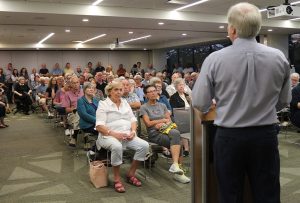
County officials will conduct small working sessions in the coming weeks with representatives from the Coalition for a Planned Reston, a grassroots umbrella organization, and Reston Association.
The meetings are intended to encourage dialogue between county staff and other organizations as the county mulls a controversial plan to increase Reston’s population density in Reston’s Planned Residential Community district from 13 to 16 people per acre.
The working sessions will cover planned future growth and its impact on transportation, schools and public facilities, parks, recreation and open space and overall planning.
CPR, which includes residents from the Reston Citizens Association, Reclaim Reston and Reston 20/20, hopes talks will allow the organization to “further clarify the modifications to the Reston Master Plan proposed by CPR and [RA]” said Lynne Mulston, a spokesperson for CPR.
Ultimately, CPR hopes changes to the Master Plan will eliminate the need or perceived need to boost the density cap.
In March, many suggestions pitched by both organizations were rebuffed by county staff, who argued that proposed changes to Reston’s PRC simply implemented the Master Plan, which was formed with community and stakeholder input.
Most recently, CPR and RA met with Hunter Mill District Supervisor Cathy Hudgins and county staff to resume discussions on May 14.
The working sessions’ statement of purpose, proposed by Fred Selden, Fairfax County Director of Planning and Zoning is as follows:
The purpose of these small group meetings is to continue the dialogue between Fairfax County staff and representatives of both Reston Association (RA) and Coalition for a Planned Reston (CPR) regarding the proposed changes to the PRC zoning district. Each small group will consist of representatives from County staff, RA, CPR and other Reston stakeholders. They will discuss future growth and its implications or impact on public facilities and infrastructure that serves Reston.
The schedule of meetings has not been finalized. CPR and RA are reaching out to subject matter experts to participate in the sessions.
File photo

More community meetings about a controversial plan to increase Reston’s population density may be forthcoming.
In an April 23 letter to the Coalition for a Planned Reston, a community group opposing the increase, Hunter Mill District Supervisor Cathy Hudgins suggested holding more meetings to discuss issues related to the proposal, which would increase population density from 13 to 16 people per acre in Reston’s Planned Residential Community areas.
Hudgins pitched the idea of holding another group meeting with CPR, Reston Association and the county’s planning staff. Work sessions in small groups would follow based on topics like infrastructure implementation, transportation, schools and parks.
CPR and RA declined to meet on April 2 to discuss the county’s response to their concerns. County planning staff reiterated the need to pursue the proposal in order to effectively implement Reston’s master plan. Staff affirmed their commitment to ensuring infrastructure matches the pace of development, but did not accept a number of amendments suggested by both parties.
In her letter, Hudgins acknowledged the county’s response was “slow in coming.”
“But a commitment was made to respond and the planning staff did so in a detailed and thoughtful manner. It is unfortunate that CPR and RA declined to meet on April 2 and to discuss the staff’s response and to outline next steps and the process going forward,” she wrote.
Hudgins also noted that Reston’s master plan includes protections for existing residential communities and Reston’s golf course.
Most of the potential growth is slated for village centers, St. Johns Wood apartments, the retail area north of Baron Cameron avenue near Home Depot, Reston Town Center North, parts of Reston Town Center and other parcels in Reston’s Transit Station Areas.
“As was evident again this year at the Founder’s Day celebration, Reston is a special place that we all love and I am confident that we can all work together to resolve the issue of the maximum density allowed in the PRC zoned area and the concerns of the community regarding the Reston Master Plan,” Hudgins said.
CPR met on Monday to discuss the county’s response. In a statement, Bruce Ramo of CPR said the opposition group is disappointed with the county’s response.
“It is evident that in the absence of leadership by the Supervisor, Restonians must step forward directly to convince the Board of Supervisors of the need for changes in the Master Plan,” Ramo wrote.
Dates regarding when the Fairfax County Board of Supervisors will officially introduce the legislative proposal have not yet been announced.

Shooting on Sunday in Ashburn — A Reston man was shot at early Sunday at a home on the 43500 block of Dunhill Court, according to the Loudoun County Sheriff’s Office. [Loudoun County Sheriff’s Office]
Population density debate fires up — The Coalition for a Planned Reston will meet tonight to discuss a proposal by the county to increase the community’s population density. [Coalition for a Planned Reston]
Bookmark this, book lovers — Friends of the Reston Regional Library will host its semi-annual book sale from Thursday through Sunday. [Friends of the Reston Regional Library]
Alcohol enforcement update — Officers from the Reston Neighborhood Patrol Unit conducted business compliance checks late last week at 11 businesses. 10 passed. [Fairfax County Police Department]
Photo by Sarah Mccue


